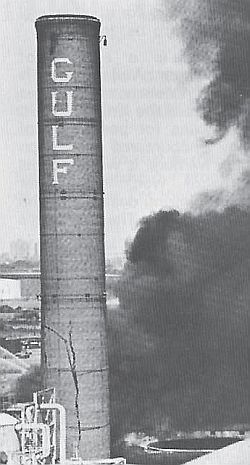
August 17th, 1975: Gulf Oil refinery fire scene near landmark stack, Philadelphia, PA.
But on August 17th, 1975 near dawn, a fire started in the refinery when a 75,000-barrel oil storage tank ignited after being filled from a docked oil tanker on the Schuylkill River. However, this fire, thought to be under control a few hours after it began, roared back to life a second time, taking the lives of several firemen already on the scene, and causing a fire-storm inferno at the Gulf complex that almost took down the entire refinery, and more.
On that Sunday morning, just after midnight, at around 12:45 a.m., the oil tanker Afran Neptune, berthed at a Gulf refinery dock, had begun off-loading its cargo of crude oil to the refinery. It was pumping reconstituted Venezuelan crude oil (containing an additional five percent naphtha) into storage tank No. 231.
This particular tank had been built in 1929 and it was located in the refinery not far from Boiler House No.4, which also had a tall brick chimney that rose high above the refinery grounds. Both were near the Penrose Avenue Bridge.
The tall stack, in particular, was a familiar landmark to Philadelphia motorists using the bridge, as it bore the giant word “GULF” in large, white letters, announcing the refinery’s owner.
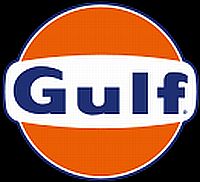
Gulf Oil Company logo.
By 1975, Gulf was among the top U.S. producers of crude oil, natural gas, and coal. Their 17,000 gas stations were found in 29 states. Gulf Oil mined uranium and also produced chemicals and plastics. Overseas, Gulf oil production came from countries such as Kuwait, Nigeria, Angola, Gabon and Zaire. On the world’s oceans, a fleet of 17 large Gulf oil tankers moved petroleum in international trade. And at least 14 Gulf-owned oil refineries in North America, like the one in Philadelphia, turned crude oil into various petroleum products.
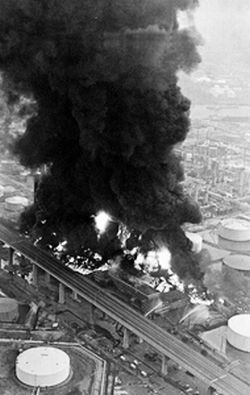
Aug 1975: Aerial view of Gulf Oil refinery fire in Phila. PA, looking down on the Penrose Ave. Bridge that crossed the refinery grounds.
The flames then followed the vapor trail back to tank No. 231 causing another huge explosion. It was about 6:00 a.m. that Sunday morning, just about sunrise.
Then a second explosion occurred at tank No. 231, as burning petroleum spilled into a diked area surrounding the tank. Another tank in that area also went up. The first explosion had damaged a nearby pipe manifold, and leaking petroleum was spewing out on the ground, which also ignited.
The first alarm for the Philadelphia Fire Department went out shortly after the initial tank explosions, followed quickly by a second alarm. Arriving firemen found large clouds of heavy black smoke coming from the two burning tanks. The 150-foot brick tower stack at the Boiler House was also showing fire with a prominent vertical crack radiating from its base.
The battalion fire chief on the scene quickly ordered a third and fourth alarm, followed by a fifth from another fire chief and then a sixth alarm from Fire Commissioner Joseph Rizzo at around 7:00 a.m.
Over the next few hours, firefighters fought the blaze with water and foam, and by 9:00 a.m. or so they thought they had the fire contained and stabilized, though it was still burning. However, there were other problems on the scene that would soon make the situation near-catastrophic.
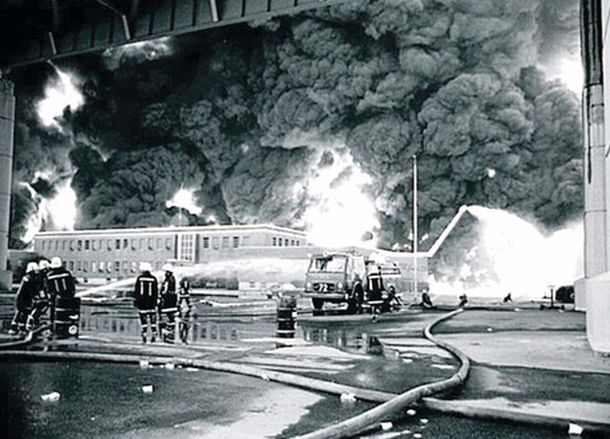
August 17, 1975: Firemen and equipment beneath Penrose Bridge as they move in to fight the Gulf Oil refinery blaze in Philadelphia, PA, with a Gulf Oil office building in the fire’s path.
It soon became apparent that the refinery’s sewerage system was not adequately draining the water and petroleum-naphtha mixture that was accumulating on the ground at the scene. In addition, the power to some of the refinery’s drainage pumps was shut off over concern for overhead power lines in the area. The liquid mixture continued to accumulate, as is seen in the photo below.
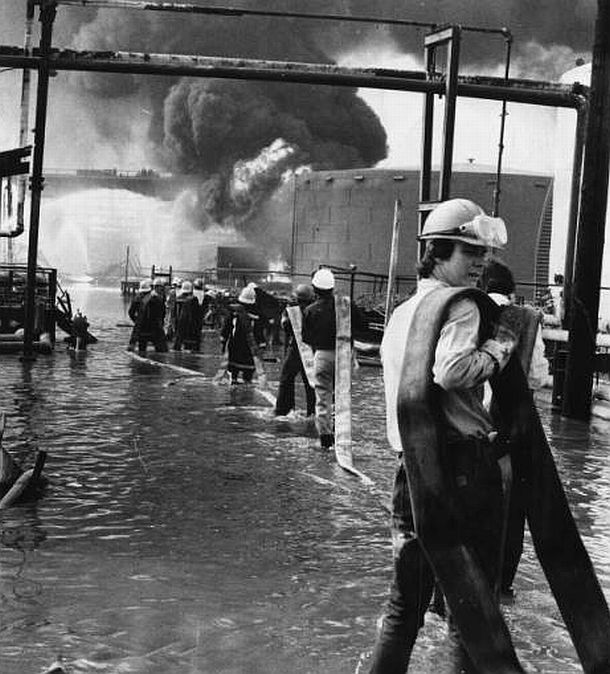
August 1975: Firemen pulling hose through the Gulf Oil Refinery in Philadelphia, PA, on their way to do battle with the fierce blaze. Note accumulating water at their feet. Dominic Ligato, Philadelphia Evening Bulletin photo /Temple Univ.
Three firemen at one point were wading in the watery mixture in an area of the refinery where they were attending to their equipment and one of the firetrucks. Suddenly there was a flash and the water was ablaze. Philadelphia Fire Commissioner Joseph Rizzo and Gulf refinery manager Jack Burk were then on an overhead catwalk nearby observing the firefighting operations when they witnessed the unfolding horror, as their men became trapped in the fiery water. “The flames just engulfed them,” said Commissioner Rizzo of his men, also describing how he escaped the first of dozens of explosions.“The flames just engulfed them…They were human torches.”
– Fire Commissioner J. Rizzo As he looked back, he saw his three men sealed in flames. “They were trying to get under the foam, but to no avail,” he said. “They were human torches.”
One firefighter that day, David Schoolfield, who was in the middle of that same tragedy and nearly lost his life, recalled the scene some years later: “The ground was full of hose lines coming from all directions. We were walking in warm oil that came up maybe 24 inches on our boots. …But they said we were controlling the fire. I believed it. Then about 3:30 that afternoon, I was on break at a Red Cross truck and I heard them call ‘firemen on fire.’ I ran in that direction. I saw three firemen in flames. They were like human torches running around in circles. They fell into the oil to try to douse themselves. They may have drowned. There was nothing I could do. Then I heard people behind me screaming for me to get out. But when I turned to run, I broke through the foam, flames shot up and I went up like a torch. …A guy named Reginald Simmons grabbed me and we got out…I remember they had to keep putting me out because my skin kept reigniting…” David Schoolfield spent the next two months in hospital burn centers for treatment of burns that covered 26 percent of his body.
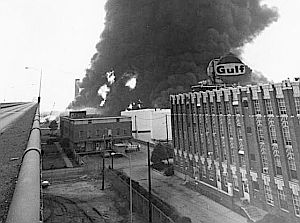 August 1975: View of the Gulf refinery fire from Penrose Bridge, looking west. Photo, Temple University |
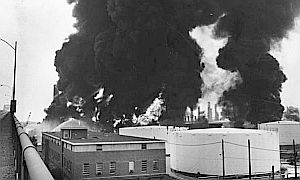 August 1975: Another view of the Gulf refinery fire from further up on the Penrose Bridge. Photo, Temple University |
In 2015, Philadelphia Inquirer reporter Aubrey Whelan noted that another firefighter at the scene, rookie Ray Rajchel, had been separated from his company, Engine 20, after he tripped and fell into the oil/water mixture. His supervisor, Lt. James Pouliot, told him to walk back to his fire truck and get hosed down before rejoining the group. Rajchel was on his way back to the previous fire location when a secondary flash explosion occurred. He watched in horror as the flames and smoke spread through the refinery and down the wide avenues between the giant oil tanks. He never again saw his supervisor, Lt. James Pouliot.
Back at the refinery in August 1975, meanwhile, a fire storm was now developing. Commissioner Rizzo ordered two more alarms, five additional rescue squads, and recalled all fire companies that had previously been released that day. It was nearly 5:00 pm, and Rizzo soon had ordered a ninth alarm. A major disaster was now unfolding at the Gulf Refinery.
The fire had already expanded eastward in the refinery, taking with it two fire department engines – No. 160 and No.133 – and also a refinery foam pumper. Two other Philadelphia fire trucks had already been destroyed in the flash explosion. Electric power and phone service also went out in the area around the refinery. The fire, meanwhile, kept spreading and was threatening four additional storage tanks, and was headed for the 125-foot Penrose Avenue Bridge. By 5:30 p.m. Rizzo ordered the tenth alarm. The fire had now engulfed the refinery’s administration building. Another fire that day in Philadelphia at a paper plant had fully taxed the Fire Department’s capabilities. By 6:00 p.m., Rizzo ordered an 11th alarm for the refinery fire and also ordered day-shift personnel held over. Explosions during the fire had put a large crack in the boiler house smokestack next to the bridge. Officials then closed the bridge for several hours, fearing that the big Gulf Oil stack might collapse on the bridge or that the encroaching fire would damage or weaken it.

Additional view of the August 1975 Gulf Oil refinery fire, likely from the Penrose Bridge, showing the intensity of the blaze as it approached the administration building, subsequently burnt to the ground. Photo, Philadelphia Inquirer.
By 7:00 p.m. Sunday evening, the burning tanks and pipelines at the refinery were still gushing flames and a number of roadways in the complex were also burning streams of oil and other petroleum products. For a time, it appeared the fire would not be stopped. This was not the first time the Gulf Oil refinery had burned. In fact, there were 10 fires there between 1960 and 1975. Contingency plans, in fact, had been made for a street-by-street, tank-by-tank retreat through the refinery. In the end, the Philadelphia Fire Department prevailed in the main battle, and by 5:38 a.m. Monday morning, August 18, 1975, the fire was reported as under control. That evening on ABC-TV, the Philadelphia fire made the ABC Evening News national news broadcast with Howard K. Smith reporting. Clips from the fire were shown as Smith explained the fire was still being battled and that six men were than lost, 4 dead and 2 missing. Back in Philadelphia, meanwhile, the fire in the original tank no. 231, was permitted to burn itself out. “Flare-ups” at the site continued for another week or so, with at least four calls to the Fire Department to assist refinery firefighters still dealing with the fire’s aftermath.

Associated Press wire photo used by The Baltimore Sun showing firemen still battling one of the tank fires at the Gulf Oil refinery in Philadelphia, PA on Monday, August 18, 1975, a day after the fire had started. “Flare ups” at the site would continue for another week following the original inferno.
Finally, on Tuesday, August 26, 1975, the fire was declared officially extinguished. However, this had not been the first time the Philadelphia Gulf Oil Co. refinery had burned. In fact, the refinery had been the scene of ten fires since 1960. On May 16, 1975, a six-alarm fire struck the Gulf Refinery. And following the big blaze of August 1975, a second six-alarm fire occurred at the Gulf refinery on October 20, 1975.
Ed Marks, among those who fought the 1975 Gulf refinery fire, recalled in a 2015 Philadelphia Inquirer interview, how subdued his firehouse was after the blaze and how it felt to visit the refinery scene two days later: “When we pulled in, it was the most eerie sense that came over you, knowing the devastation and the loss of life that had just occurred. It was complete and total devastation. The refinery administration building burnt to the ground, the twisted steel, every vehicle burnt down to the skeletons.”
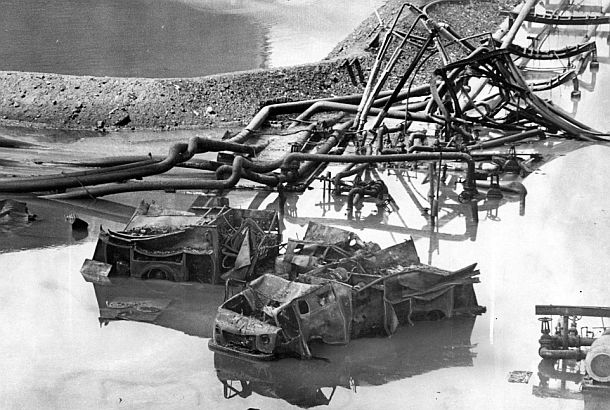
Philadelphia Evening Bulletin photo of burnt out and twisted remains of Gulf Oil refinery apparatus near storage tank earthen dike with fire truck and pumper skeletons in foreground, August 1975, Philadelphia, PA.
|
“The Daily Damage” This article is one in an occasional series of stories at this website that feature the ongoing environmental and societal impacts of industrial spills, toxic releases, fires, air & water pollution incidents and other such occurrences. These stories will cover both recent incidents and those from history that have left a mark either nationally or locally; incidents that have generated controversy in some way, brought about governmental inquiries or political activity, and generally have taken a toll on the environment, worker health and safety, and/or local communities. My purpose for including such stories here is simply to drive home the continuing and chronic nature of these occurrences through history, and hopefully contribute to public education about them so that improvements in law, regulation, and industry practice will be made, and that safer alternatives will replace them in the future. — Jack Doyle |
The initial cause of the August 1975 inferno at the refinery was the overfilling of tank no. 231. Large quantities of hydrocarbon vapors had been trapped at the top of the big storage tank above the crude oil. As the quantity of crude oil in the tank increased, these hydrocarbon vapors were forced out of the tank’s vents and into the area of the boiler house where the initial ignition occurred. The overfilling of the tank had resulted from a failure of the tanker’s personnel to properly monitor the quantity of crude oil being pumped into the tank. After the first explosion and initial fire, the supplying tanker terminated its pumping, left its Schuylkill River berth, and relocated to the piers at Hog Island. But beyond the first cause, there were other contributing circumstances — and some might say outright negligence — that made the fire a much bigger catastrophe than it should have been.
Remaining Issues
Less than two months after the Gulf Oil fire in Philadelphia, on October 12, 1975, another oil refinery fire occurred in the city – this one at the Atlantic Richfield (ARCO) refinery not far from the Gulf refinery. The ARCO fire went to nine alarms with more than 200 firefighters involved, but had no loss of life.
Still, this fire, coupled with the Gulf blaze and other incidents in the 1970s, prompted then Pennsylvania attorney general, Robert Kane, to form a special governors task force to begin an investigation into Philadelphia-area oil refinery fires and explosions. “We are going beyond that (the Gulf fire) to deal with all the refinery fires in Pennsylvania during the past 10 years to determine whether there is a risk and what can be done to correct it,” Kane told the Philadelphia Inquirer on October 13th, 1975. The group had already held its first session in early October. The special task force proposed to look into a series of oil-related incidents in the Philadelphia area that occurred in the 1960s and 1970s. There had been more than 50 people killed in those incidents. (A January 1977 Philadelphia Inquirer story indicated that the task force investigation was still ongoing, and that a draft had been prepared).
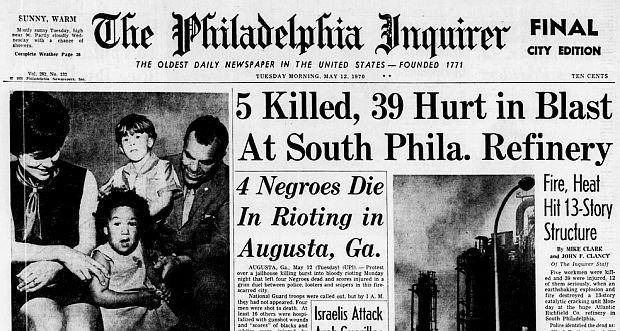
Philadelphia Inquirer headlines from May 12th, 1970, reporting on one of the earlier refinery incidents in South Philly, this time at the Atlantic Richfield refinery (later known as ARCO), where a catalytic cracking unit explosion would, in the end, kill seven.
In addition to the Gulf refinery fire, which killed eight firemen and caused an estimated $10 million in property damage, the task force was expected to investigate several other refinery- and oil-related incidents in the area. Included among these were the following: the January 31, 1975 explosion of the Greek oil tanker Corinthos and the death of 25 crewmen at British Petroleum’s dock in Marcus Hook after it was struck by the S. S. Edgar M. Queeny; the April 9, 1974 explosion of the Greek tanker Elias at the ARCO dock on the Delaware River, killing 12; and the May 11, 1970 explosion of a 13-story catalytic processing unit at the ARCO refinery, killing seven workers. There had also been numerous smaller incidents at area refineries in the 1960s, most of which were non-fatal fires – and eight of which occurred at the Gulf refinery between 1966 and the 1975 blaze. One of the worst of these occurred on September 9, 1960, when lightning touched off an eight-alarm, $l-million blaze that destroyed 20 large storage tanks.

UPI wire story, New York Times, July 7, 1977, p. 27.
In July 1977, there were some news reports indicating that Gulf Oil – in connection with the 1975 refinery fire – was cited with 172 violations of the city fire code and fined for a portion of those, some of which may have been subsequently waived. And while there may also have been state actions taken and/or private lawsuits brought against Gulf Oil for its liabilities in the 1975 refinery fire – possibly with out-of-court settlements – this website has not yet found any record of those (Note: for readers who may know of such records, or details of the state’s oil industry investigation, please forward any links or related materials, or contact Jack Doyle at the email address below).
Firemen Honored
Six firefighters lost their lives at the scene during the August 1975 Gulf refinery fire; two others died later of burns, and at least 14 others were treated for burns and injuries. The Gulf Oil refinery fire of 1975 is still remembered in Philadelphia, especially among friends and family of those lost in the blaze and by the Philadelphia fire-fighting community. In August 2007, about 200 people gathered at the Fireman’s Hall Museum in Philadelphia as plaques were unveiled to honor the firefighters who lost their lives in the Gulf Oil refinery disaster. Again, in August 2015, marking the 40th year of the fire, city and fire department officials, survivors, and family members gathered in remembrance of the tragedy with a ceremony at the Fireman’s Hall Museum.
Two additional stories at this website on the history of oil refinery fires and explosions include: “Texas City Disaster: BP Refinery, March 2005” (about BP’s negligence in the 2005 Texas City, TX oil refinery explosion & fire that killed 15 workers and injured another 180, including 60 Minutes TV coverage and details on related litigation); and, “Inferno at Whiting: Standard Oil, 1955” (story about the eight-day catastrophic oil refinery fire near Chicago in 1955, and later leaks, spills, and waste issues at the refinery under Amoco and BP management).
Other stories of possible interest at this website include: “Burn On, Big River,” about oil-pollution fed Cuyahoga River fires near Cleveland, Ohio; “Offshore Oil Blaze,” an account of a major offshore well blowout and fire at a Shell Oil Co. rig in the Gulf of Mexico; and “Plastic Infernos,” a brief history of toxic dangers found in high-rise and other fires with high plastics content. Thanks for visiting – and if you like what you find here, please make a donation to help support the research and writing at this website. Thank you. – Jack Doyle
|
Please Support Thank You |
____________________________________
Date Posted: 15 February 2015
Last Update: 29 April 2021
Comments to: jdoyle@pophistorydig.com
Article Citation:
Jack Doyle, “Burning Philadelphia: Refinery Inferno, 1975,”
PopHistoryDig.com, February 15, 2015.
____________________________________
Sources, Links & Additional Information
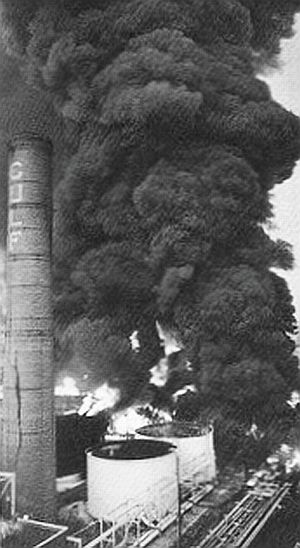 Another view of the August 1975 Gulf Oil refinery fire in Philadelphia, PA with the former landmark brick boiler stack, ruined in the blaze. |
 Fireman on firetruck No. 133 and other men fighting blaze at Gulf Oil refinery, photographed not long before this area went up in flames, destroying the firetruck and killing some of the firefighters. |
Associated Press, “Philadelphia Blaze At Gulf Fuel Plant Kills 3 Firefighters,” New York Times, August 18, 1975.
“3 Firemen Die Fighting Philadelphia Oil Blaze,” Chicago Tribune, August 18, 1975, p. 3.
“Refinery Fire, Philadelphia,” ABC Evening News, Howard K. Smith, Monday, August 18, 1975.
“2 Brave Hot Oil to Close Valve at Refinery Fire,” Los Angeles Times, August 19, 1975, p. 4.
“Philadelphia Firemen Keep Watch at Site of Oil Blaze,” New York Times, Wednesday, August 20, 1975, p. 12.
“Fear of New Blast at Refinery Forces Shutdown of Bridge,” Los Angeles Times, August 21, 1975, p, B-14.
United Press International, “7th Philadelphia Fire Victim,” New York Times, August 26, 1975
“Philadelphia Fire Burns Out,” New York Times, Wednesday, August 27, 1975, p. 12.
Murray Dubin, “Kane’s Refinery Study, Begun in 1975, Is Still Out,” Philadelphia Inquirer, January 25, 1977, p. 9-A.
Elmer Smith, “30 Yrs. Later, Memories of a Refinery Inferno; Gulf Oil Refinery- Philadelphia, Pa. 30 Years Ago; Tragic Fire Revisited,” Philadelphia Inquirer, August 17, 2005.
Vernon Clark, “City Honors 8 Firefighters Lost in 1975,” Philadelphia Inquirer, August 16, 2007, p. B-1.
Mike Pence & Bob Burns, View From The Bridge, “The 1975 Philadelphia Gulf Oil Refinery Fire,” Fire World, Volume 22, No. 6, November 2007.
Robert Burke, “Remembering the Gulf Oil Refinery Fire,” Firehouse.com, December 3, 2010.
Christopher R. Dougherty, “A Petaled Rose Of Hell: Refineries, Fire Risk, And The New Geography Of Oil In Philadelphia’s Tide- water,” HiddenCityPhila.org, December 10, 2013.
“Gulf Oil Refinery Fire, August 1975,” George D. McDowell / Philadelphia Evening Bulletin Photographs, Digital Library, Temple University, Philadelphia, PA
Kristen A. Graham, “George Schrufer, 72, Firefighter Who Survived 1975 Gulf Refinery Blaze,” Philadelphia Inquirer, December 21, 2014.
Aubrey Whelan, “Ceremony Marks 1975 Gulf Oil Refinery Blaze That Killed Eight Firefighters,” Philly.com, August 17, 2015.
Max Marin, “South Philly Refinery’s Long History of Fires, Explosions, Deaths and Injuries,” BillyPenn.com, June 21, 2019.
_________________________